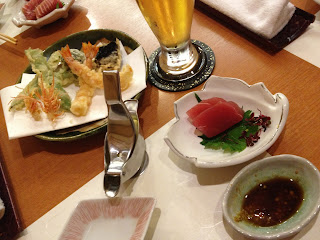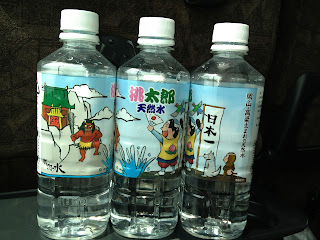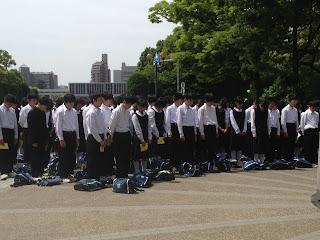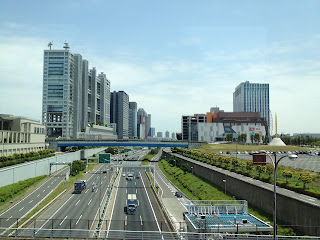Japan, May 9 - 28, 2013
(Click on images to enlarge)
The iconic Torii at Miyajima
We had long wanted to visit Japan. Todd made an abortive attempt to study Japanese at Stanford, and Georgia developed a love for sushi after arriving in New York after college. But our Foreign Service assignments took us to Europe and Latin America rather than Asia.
Opportunity
beckoned with the receipt of a brochure advertising a May 2013
Stanford alumni travel/study tour “Japan by Sea,” co-sponsored by MIT and the American Museum of Natural History. This program featured 11 nights on a
Bahamian-registered 115-passenger passenger ship that could call at smaller
ports in Japan’s Inland Sea, Korea, and northern Honshu, preceded by two nights
in Kyoto and followed by a final night in Tokyo. We decided to sign up for the tour but add extra days
on our own, two in Kyoto and four in Tokyo.
This
expanded itinerary included the following highlights:
-- Kyoto,
seat of the emperor until 1865: Golden Pavilion, Silver Pavilion, Nanzen-ji,
Tenryu-ji, and Sanjusangendo-ji Buddhist temples with a lecture on Zen Buddhism
by an American monk; visit to Miho Museum in the hills outside of Kyoto;
-- Nara,
the older Japanese capital, with historic Todai-ji and Horyu-ji Buddhist temples;
embarkation on the Caledonian Skye;
-- Naoshima, a fishermen’s island in the Inland Sea that
has reinvented itself as an art and architecture center with works in museums,
including the extraordinary Chichu Museum designed by Tadao Ando, and outdoor
sculptures;
-- Hiroshima,
where the park and museum commemorating the atomic bomb attack are surrounded
by a very attractive city;
-- Miyajima, reachable by the ship's zodiacs, featuring an iconic 6th century Shinto shrine extending into the
Inland Sea;
-- Hagi,
a northern Honshu ceramics center with a samurai quarter that recalls the city’s role as the wellspring of the 1860’s
revolution that led to the Meiji Restoration, ending the Tokugawa Shogunate and
introducing western-style polity to Japan;
-- Ulsan,
Korea (a side trip necessary to avoid violation of Japan’s cabotage laws)
with a bus trip to Gyeongju, one of the great cities of the world in the first
millennium C.E. with its 6th century Bulguksa Buddhist temple;
-- Matsue, a
port city in northern Honshu, which features
a six-story 17th century castle and the new Adachi Museum of Art
outside the city with superb traditional-style gardens integrated into the
museum complex;
-- Kanazawa,
also in northern Honshu, with the 25-acre Kenroku-en, begun in the 16th
century and now often considered to be the finest traditional garden in Japan;
tea ceremony in the garden’s tea house; the geisha tea house district Higashi
Chaya;
-- Sado
Island, off northern Honshu, where we heard an ear-splitting performance of
the Kodo (“heartbeat”) drumming group and visited a paddy in this region
renowned for its high quality rice;
-- Niigata,
disembarking from the Caledonian Skye
and boarding the shinkansen (“bullet
train”) to Tokyo;
-- Tokyo, where
we parted company with the tour and set off on four wonderful days of
sightseeing, staying at International House, a private club, thanks to the intervention
of Todd’s good friend from grad school.
The following
observations from our trip are arranged by subject but reference the above
itinerary.
Religion
Much of our
sightseeing involved visits to Shinto shrines and Buddhist temples,
representing the two major religions in Japan. However, we also saw a number of Christian churches,
Protestant and Catholic, and some imposing houses of worship of the so-called
“new religions,” whose theologies represent amalgams of the tenets of other
faiths. Japanese frequently
combine Shinto rituals with Buddhist practices, an interesting variant on
Pascal’s Wager.
Shinto, “the
way of the gods,” is the older religion, teaching that deities (“kami”) hold sway over all things in
nature, animate and inanimate.
Tied to the imperial family, who were supposedly descended from the
greatest kami, Shinto was the state
religion from the mid-19th century to the U.S. occupation, when it
was disestablished. The
larger Shinto shrines, where the kami are
worshipped, are usually marked by a square gateway (“torii”), somewhat similar to the entrance gate to a ranch in the
western United States.
Meiji Shrine, Tokyo
Meiji Shrine, Tokyo
However,
other Buddhist sects reflect Hindu admixtures and are anything but serene. The most extreme example was the
Sanjusangen-do Temple in Kyoto, which features 1001 life-size statues of
Kannon, the Buddhist goddess of mercy, with a number of her fearsome
protectors. Photography was not
permitted in that sanctuary, but the following photos portray the impressive
deities we encountered in other such temples.
The Buddha at Todai-ji Temple, Nara
Buddhist god at Todai-ji Temple, Nara
The Buddha at National Museum, Gyeongju, Korea
Guardians at the Bulguksa Temple, Gyeongju, Korea
Bulguksa Temple with lanterns celebrating Buddha's birthday, Gyeongju, Korea
Senso-ji Temple, Tokyo
Senso-ji Temple, Toyko: Pilgrims cleansing themselves with incense
Weddings
Perhaps
because of the wonderful weather we enjoyed, love was in bloom throughout our
travels. Most bridal couples wore
traditional Japanese outfits, especially at the Meiji Shrine in Tokyo, a
popular wedding venue. However, a
reportedly growing interest in Christian ceremonies was reflected in a series
of weddings we saw one day in a makeshift church, normally the cocktail lounge, at
Kyoto’s Crown Plaza Hotel.
Here the brides wore western-style white gowns, and music was provided
for all the ceremonies by a four-piece string ensemble and two vocalists who
sang several recognizable hymns, sometimes in English. The denominational affiliation of the
officiant was not obvious.
Meiji Shrine, Tokyo
Miyajima
International House, Tokyo
ANA Crown Plaza Hotel, Kyoto
Japanese
wedding photos, in full dress, are sometimes taken well before the ceremony for
incorporation in a souvenir album for distribution to guests at the wedding
itself. We were fortunate to
see one such photo-shoot in the geisha tea house sector of Kanazawa, where the
groom literally threw himself into the spirit of the occasion. The figure
on the ground is a photographer, who was apparently seeking a worm’s eye
perspective.
Food
As sushi lovers,
we felt impelled to watch the tuna auction at Tokyo’s famed Tsukiji Market. However, attendance required arrival at
the market by 4:15 a.m. as admission is limited to 120 people. Having barely made the cut, we were
treated to a 90-minute wait on the floor until our cohort could enter. (We must have been the oldest attendees
by 20 years!) Once in, we watched
the buyers pick at the frozen tuna carcasses with hooks to judge their quality
and make their bids with flicks of the wrist while the auctioneer carried on in
a language unintelligible to a native Japanese speaker in our cohort. The winning bids reportedly worked out
to around $200 per kilo. According to
our guide on the Stanford tour, the fish are usually caught in the strait
between Hokkaido and Honshu and frozen on board the fishing boats en route to
Tokyo.
Waiting to be admitted to tuna auction at Tsukiji Fish Market, Toyko
Video of tuna auction
We had been
told that it was impossible to get a bad meal in Japan, and our experience certainly
did not contradict that proposition.
Shabu-shabu dinner in Kyoto
Kaiseki ryori dinner
Carmelized eel, one of our favorites
Dessert at tempura restaurant: taiyaki ("baked sea bream") with iced coffee
Featuring
sushi, sukiyaki, or tempura, our restaurants were chosen on the recommendation
of a hotel concierge or a Japanese friend. Several were remarkably small, accommodating less than 15
diners. Food selection was
simple at one sushi place, where we could pick our choices off a conveyor belt
with our bill determined by the number of plates stacked in front of us. Elsewhere, we resorted to pointing at
pictures of our desired dishes on the menu.
Our most
memorable culinary experience was dinner at “No. 1 Tsukiji Sushi Restaurant”
near the Tokyo fish market. We
were the only gaijin in this far from
swanky establishment, although we discovered that the Japanese on the next
counter stool was an engineering professor at Northwestern, who came there on
every trip home. The sushi makers,
who sliced up the still wriggling fish in front of us, were more than
hospitable and encouraged Georgia to photograph their endeavors. We have never eaten such sushi.
History and Politics
We visited
Tokyo’s Yasukuni Jinja (“Shrine of Peace for the Nation”), which enshrines the
dead from Japan’s wars beginning with the civil strife preceding the Meiji
Restoration and ending with World War II.
It is an unsettling place for Japan’s neighbors and many Japanese, for
the enshrined include Prime Minister Tojo and other war criminals involved in
World War II and the invasions of Korea and Japan. A Japanese friend explained to us that in his country’s
culture men do not bear the stain of evil deeds after their deaths, as they do
in Korea and China--an interesting reverse spin on Mark Antony’s speech in
“Julius Caesar.”
Torii at Yasukuni Shrine, Tokyo
Yasukuni Shrine, Tokyo
Located on
the grounds is a museum presenting Japanese military history beginning with the
Meiji Restoration. Some exhibits,
with legends frequently translated into English, extol Japanese military
exploits and present a somewhat lopsided version of World War II. However, the background of the decision
to surrender is described in considerable, and accurate (as far as we know),
detail. Photography is not
permitted in the museum proper, but the outer lobby contains military
artifacts, including a locomotive from the Burma Railway, the subject of the
novel and movie “The Bridge over the River Kwai.”
Visits to
the shrine by members of Prime Minister Abe’s government have sparked
controversy, not only abroad but in Japanese politics, because of the
association of the shrine with right-wing groups who lament the
disestablishment of Shinto and the degrading of the emperor’s status. These groups reportedly employ
black vehicles with traditional “rising sun” flags, one of which we saw parked
outside the shrine. No English
translations were provided for the writing on the van’s sides, but we assume
the occupants were not demonstrating for world peace and brotherhood.
Life at Sea
The
115-passenger Caledonian Skye was a
very comfortable vessel with roomy staterooms, good food, and an excellent
staff. Our experience aboard was
much different from a typical cruise, however, for we had little time on our
own except for sleeping. The ship
moved from port to port at night, and we were usually ashore during the day except
for meals and presentations by the lecturers from our three sponsoring
institutions: Lt. Gen. (ret.) and former Ambassador Karl Eikenberry from
Stanford, Prof. Michael Golay from MIT (who discussed the Fukushima nuclear
plant disaster), and Dr. Laurel Kendall from the Museum of Natural History—all
of whom were excellent. The great
advantage of sea transport was the freedom from packing and unpacking as we
moved from place to place.
Museums
A wealthy devout
Muslim reportedly gives thanks for his financial success by building a mosque,
but—as far as we could see—a Japanese tycoon builds a museum. We visited several of these institutions,
each outstanding in its own right.
Perhaps most
famous is the Miho Museum in the mountains about an hour from
Kyoto. Considered one of the
masterworks of I.M. Pei, the museum is nestled into the mountainside, half ecological
and half science-fiction.
Perhaps because the Japanese collection was on tour, the art works were
less impressive than the museum itself.
Naoshima
is a fishermen’s island in the Inland Sea that has reinvented itself as an art
center. The island is home to two museums, both
designed by Tadao Ando, but it also hosts outdoor sculptures and a number of
“art house” mini-museums in converted houses. Most impressive is Ando’s Chichu Art Museum,
built almost entirely underground, with just a handful of works by Claude
Monet, James Turrell, and Walter de Maria. The works of the latter two artists are so massive that they
occupy entire rooms, obliterating the distinction between art and
architecture. The Chichu bans photography,
but this is not a tragedy as there is no way to capture the museum’s room-sized
art in a two-dimensional representation.
In Tokyo we
visited the Ukiyo-e Ota Museum and the Mori Art Museum on the 53rd
floor of the Mori Tower. The
former is devoted to woodblock prints, many by Hokusai, and the latter featured
a special exhibit “All You Need Is Love” with edgy works from west to
east. We saw everything from
some very explicit 19th century woodblocks (only 20-year-olds and
above could pass behind the black curtain where photography was strictly
forbidden) to Chagall, Brancusi’s “The Kiss,” and a psychedelic light
show. This was definitely art in
the new Japan.
Kids
Japan’s
birth rate may be low, but you would never know it from the swarms of school
children we encountered at popular tourist sites. Everyone seemed eager to greet us, from very small children
on our ship’s piers to teenagers anxious to practice their English. We were interviewed several times as
part of class exercises, and we embarrassed ourselves by an inability to name
our favorite Japanese cartoon characters, who are omnipresent in advertisements
and souvenir shops. The
interviewers reciprocated by posing with us for photographs, often making a “V”
sign, whose meaning (if any) we could never conclusively determine.
Hiroshima
Sobering is
the right word to describe the peace park and museum built near ground zero of
the atomic bomb blast. Like other
members of our generation, we had read a great deal about Hiroshima, but the
extent of the destruction only became really clear when we walked through the
park and viewed photographs of the area before and after August 6, 1945. Ironically, because of the waterways
that crisscross the city (which had made fire-bombing relatively ineffective,
leading U.S. planners to employ the atomic bomb there), Hiroshima is one of the
loveliest urban areas we visited.
Surviving building, Hiroshima
School children visiting memorial
Museum depiction of post-blast destruction
Peace Park from museum
Tokyo
With a
population of 13 million, Tokyo is a world unto itself. It is actually a collection of several
urban centers that have grown together and are now connected by an exceptionally
efficient transport system composed of subways, trains, monorail, and
buses. Observing admonitions
to avoid rush hour, we found the subway system pleasant and easy to use, for
all signage and even ticket machine instructions are translated into English. We traveled using a rechargeable card,
essentially like DC Metro’s SmartTrip card, to spare ourselves the bother of
calculating the fare for each trip.
The city
spreads out in all directions, and we traveled to some distant sectors, such as
a the futuristic island of Odaiba, to visit certain sites. However, our attention was focused on
the central portions, including Ginza, which features daytime shopping and
evening entertaining, and Roppongi, the night life center where we stayed at
the International House, an oasis of quiet with its beautiful garden.
Tokyo view from Mori Tower
Odaiba, Tokyo
Shibuya Crossing, Tokyo
Tokyo Tower from Roppongi
Our favorite department store: Mitsukoshi in Ginza
Garden at International House, Tokyo
In the
center of Tokyo is, of course, the emperor’s residence, no more open to the
public than Buckingham Palace, although we could stroll through the grounds.
Imperial Palace, Tokyo
Odds and Ends
21st century Japanese toilets
are a subject of fascination for many American tourists who appreciate the warm
seats and bidet functions.
However, we also encountered another feature, which the following photo
explains.
We never saw
one of Tokyo’s cat cafes, where patrons reportedly pay for the privilege of
petting the feline residents, but we did see a number of dogs—almost all very small. Our 60-pound Lab would be a giant in
Japan. Asked about this, a
Japanese friend explained that larger canines are not banned or more heavily
taxed, but small urban living spaces make smaller pooches more attractive as
pets.
We saw little
to disabuse us of our preconception that Japanese are orderly, law-abiding
people, but there was an occasional exception.
Sayonara
Sayonara
From our stateroom window at Kanazawa




























































